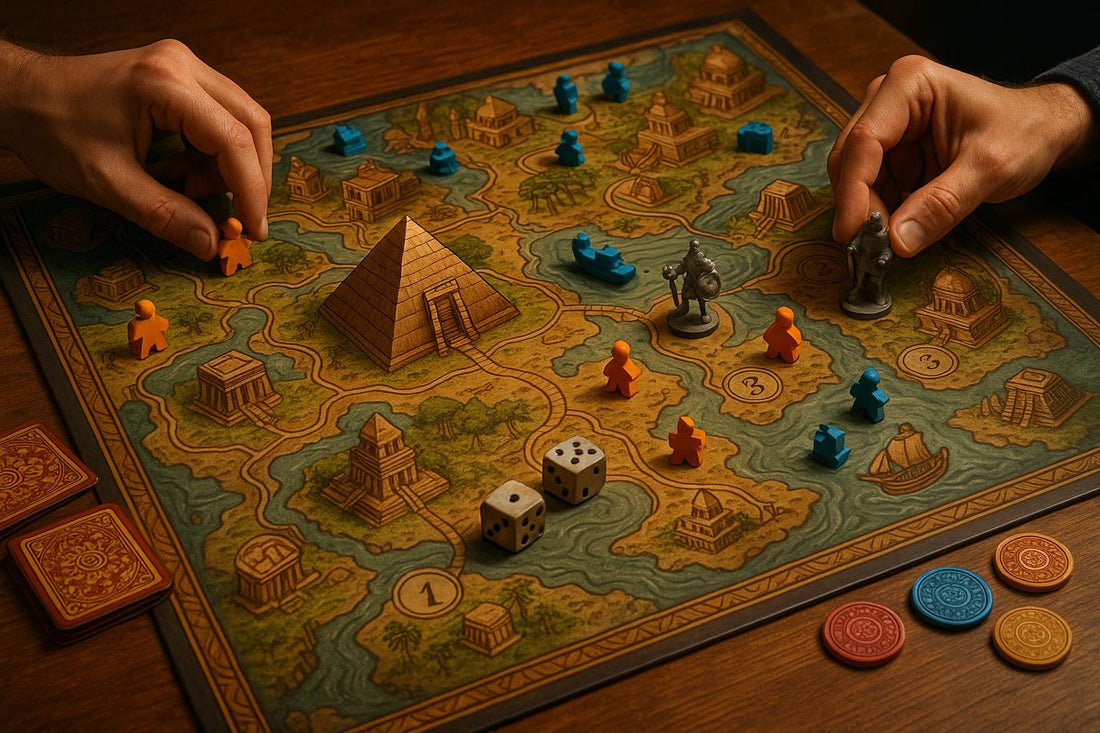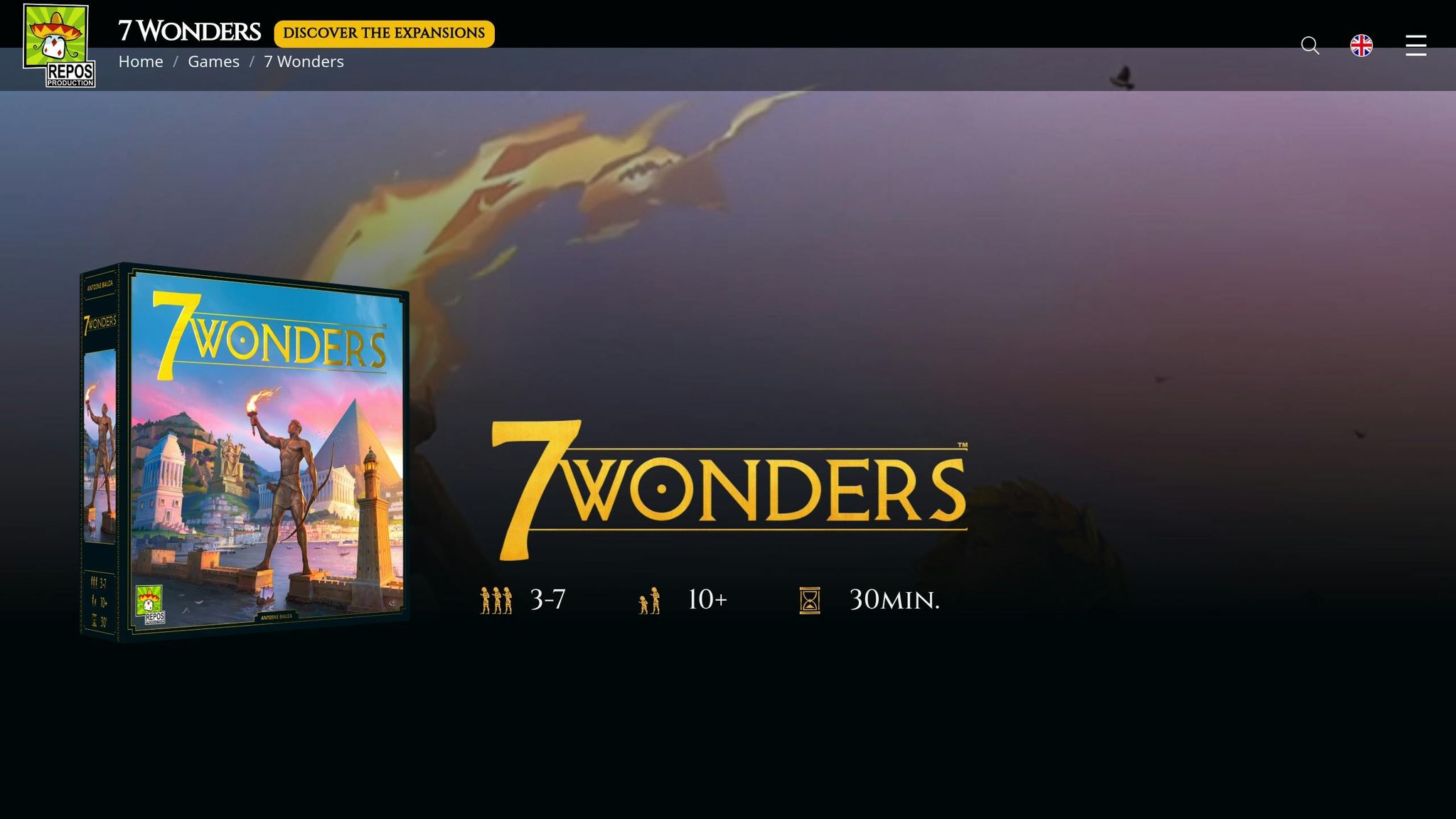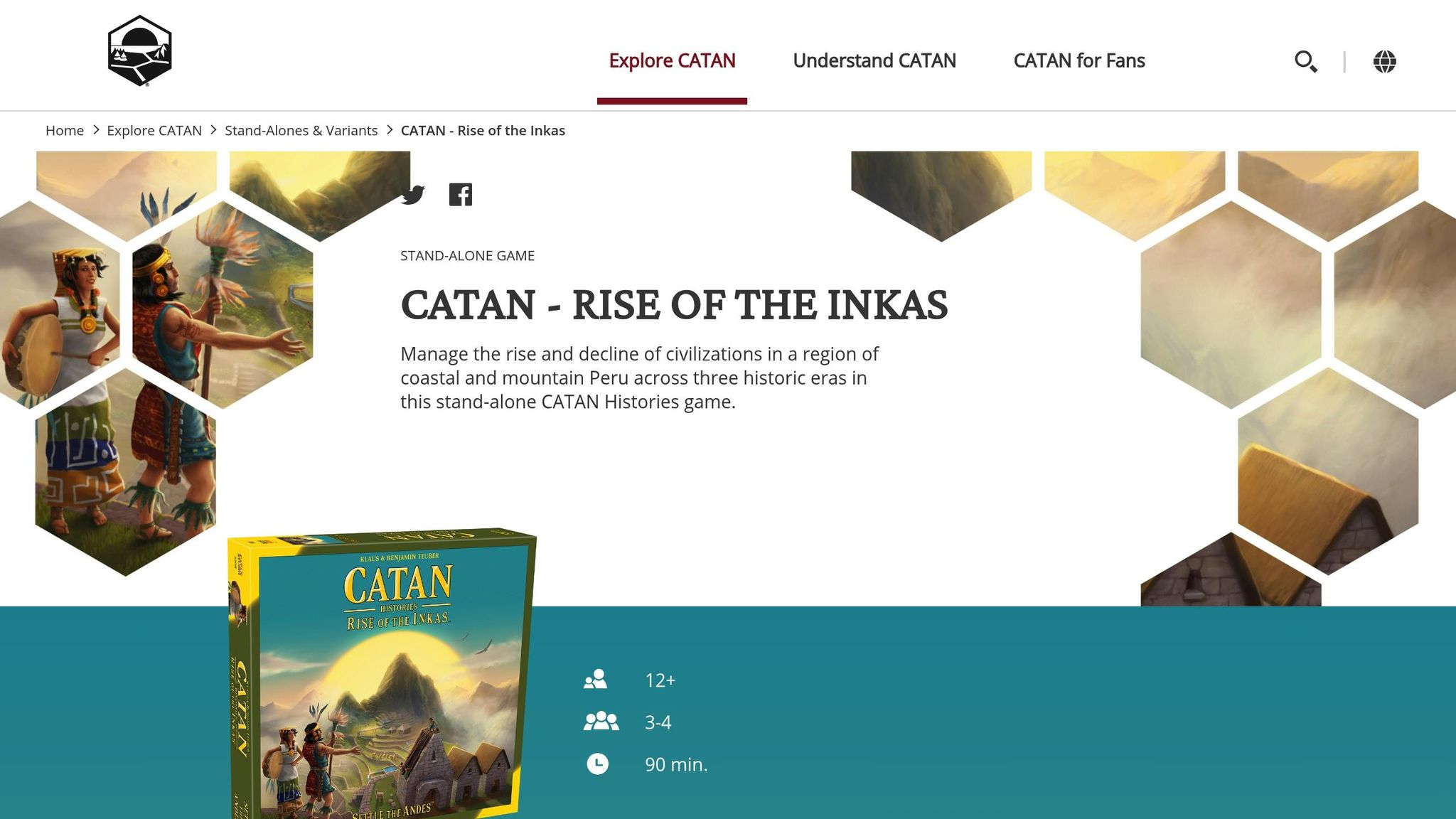Discover the Best Board Games for Every Player

Top 7 Ancient Civilizations Board Games
Love history and board games? Combine both with these 7 ancient civilization-inspired board games that bring the past to life while challenging your strategy skills.
Here’s a quick look at these games:
- Senet: The oldest board game, symbolizing the soul's journey in ancient Egypt.
- Royal Game of Ur: A Mesopotamian race game blending strategy and chance.
- Tigris & Euphrates: Build balanced kingdoms in ancient Mesopotamia.
- 7 Wonders: Construct iconic monuments from the ancient world.
- Catan: Rise of the Inkas: Manage resources in pre-Columbian Andean societies.
- Imhotep: Take on the role of an Egyptian builder creating monuments.
- Carcassonne: Hunters and Gatherers: Survive and thrive in the prehistoric Stone Age.
These games mix fun with history, offering insights into ancient cultures, strategic gameplay, and endless replay value.
Quick Comparison Table:
| Game | Era/Region | Focus | Gameplay | Playtime | Ages |
|---|---|---|---|---|---|
| Senet | Ancient Egypt | Spiritual journey | Strategy with symbolic meaning | ~30 mins | 8+ |
| Royal Game of Ur | Mesopotamia | Race and chance | Dice-based race mechanics | ~30 mins | 10+ |
| Tigris & Euphrates | Mesopotamia | Balanced kingdom building | Tile placement, conflict | ~90 mins | 12+ |
| 7 Wonders | Ancient World | Monument construction | Card drafting, resource trade | ~30 mins | 10+ |
| Catan: Rise of the Inkas | Pre-Columbian Andes | Resource management | Hex-grid, displacement mechanic | ~90 mins | 12+ |
| Imhotep | Ancient Egypt | Monument construction | Resource management, timing | ~40 mins | 10+ |
| Carcassonne: Hunters... | Stone Age | Survival and resource use | Tile placement, scoring strategy | ~35 mins | 8+ |
Dive into the full article to explore how these games bring history to your tabletop!
1. Senet: Ancient Egyptian Board Game
Historical Background
Senet holds the title of the world's oldest board game, with its origins tracing back to 3100 BC in ancient Egypt. By 1300 BC, during the New Kingdom period, it had grown into a game with profound spiritual significance .
The word "senet" translates to "passing", symbolizing both the movement of game pieces and the soul's journey through the afterlife. Archaeologists have unearthed Senet boards in royal tombs, including five from King Tutankhamun's burial chamber . A notable wall painting in Queen Nefertari's tomb even depicts her playing Senet, underscoring the game's importance in Egyptian culture .
This rich history has shaped how Senet’s rules are understood and interpreted today.
Game Rules
Modern interpretations of Senet’s rules stem from extensive research over centuries. Between 1500 BC and 1300 BC, the game evolved from a casual pastime into a symbolic representation of the soul's journey through the underworld.
"In the New Kingdom, the game senet, which means 'passing,' became associated with the journey to the afterlife... Because of this connection, senet was not just a game; it was also a symbol for the struggle to obtain immortality, or endless life." - The Metropolitan Museum of Art
Learning Aspects
Playing Senet provides a window into ancient Egyptian life and beliefs. It offers opportunities to:
- Understand the daily life of ancient Egyptians
- Delve into their concepts of the afterlife
- Hone strategic thinking skills
- Experiment with probability and planning
Replay Value
Senet captivated players for nearly 3,000 years, remaining popular until the first century AD. Modern recreations combine strategic gameplay with a sense of historical immersion. By blending Egyptian mythology with social traditions, these reproductions create a unique experience that connects players with history while encouraging community interaction.
2. Royal Game of Ur: Classic Mesopotamian Game

Historical Background
The Royal Game of Ur is one of the oldest known board games, with origins tracing back to ancient Mesopotamia around 2600–2400 BC. For over a thousand years, it was a beloved pastime in the region.
Archaeological finds reveal that the game was not confined to Mesopotamia. Boards have been discovered across the Middle East and Mediterranean regions. By 1800 BC, it had reached the Levant, made its way to Egypt by 1600 BC, and eventually spread to places like Cyprus and Nubia. These discoveries highlight the game's widespread appeal and its cultural significance.
Game Rules
A Babylonian clay tablet from the second century BC provides details about how the game was played. Two players would race their pieces along a track, using pyramid-shaped dice to determine their moves.
Learning Aspects
The Royal Game of Ur isn't just a game - it’s a learning tool that still resonates today. It sharpens strategic thinking, helps players understand probability, and reinforces basic arithmetic through move calculations. Beyond these skills, the game offers a glimpse into ancient Mesopotamian life. Certain squares on the board were believed to hold spiritual significance, with players interpreting their landings as messages from gods or ancestors.
Replay Value
"You would think a game that has lasted millennia would be fun, and it is fun!" - Irving Finkel
The game's charm lies in its balance of strategy and chance. Matches typically last about 30 minutes, making it perfect for multiple rounds. Over its 1,200-year history, variations in board design kept it fresh and engaging for generations. Although the original game faded in late antiquity, its legacy lived on through adaptations like Aasha, played by the Jewish community in Kochi, India.
3. Tigris & Euphrates: Build Ancient Kingdoms
Historical Background
Tigris & Euphrates takes players back to ancient Mesopotamia, a region nestled between the Tigris and Euphrates rivers. Known as the "Cradle of Civilization", this fertile land gave rise to groundbreaking advancements like agriculture, writing, and the wheel - cornerstones of human progress.
The game draws inspiration from the dramatic history of empires like Sumer, Akkad, Babylonia, and Assyria. These civilizations thrived thanks to the rivers, which provided water for drinking, farming, and transportation. This historical richness shapes the game's strategic elements, immersing players in the challenges of building and maintaining a kingdom.
Game Rules
At its core, Tigris & Euphrates is a tile-placement game where each tile represents one of four key aspects of ancient life:
- Blue tiles: Farming and irrigation
- Black tiles: Government
- Green tiles: Trade
- Red tiles: Religious influence
Players take two actions per turn, which could involve placing leaders, laying tiles, or sparking conflicts. The scoring system is unique - your final score depends on your weakest category, encouraging players to maintain balance across all areas.
Learning Aspects
Beyond its strategic gameplay, the game offers a glimpse into the complexities of ancient Mesopotamian life. It highlights how these societies managed key aspects of civilization, including:
- Efficiently cultivating agriculture along river systems
- Integrating temples and religious practices into governance
- Establishing extensive trade networks
- Developing political systems and early legal codes
Through these mechanics, players gain a deeper appreciation for the interconnectedness of these elements in sustaining a thriving kingdom.
Replay Value
One of Tigris & Euphrates’ standout features is its replayability. The dynamic board and strategic depth keep each session fresh. Nate Owens captures this sentiment perfectly:
"The game really does feel like the rise and fall of kingdoms and rulers. There's an epic sweep to how kingdoms expand and are then devastated, how rulers can do so well and then fall to their rival dynasties."
With its ever-changing board, players must constantly adapt, mirroring the unpredictable rise and fall of ancient empires. This constant evolution ensures the game remains engaging, no matter how many times you play.
4. 7 Wonders: Build Ancient Monuments

Historical Background
In 7 Wonders, players step into the ancient world, taking on the challenge of constructing some of history's most iconic monuments. Each player is assigned a Wonder board that represents one of the Seven Wonders of the Ancient World - like the Pyramids of Giza or the Hanging Gardens of Babylon. These Wonders serve as the heart of each player's civilization, setting the tone for the game’s immersive and unique gameplay.
Game Rules
The game unfolds over three Ages, where players select cards to develop various aspects of their empire, including military power, scientific advancements, trade, and civic achievements. To complete stages of their Wonder, players need to gather specific resources, often trading with neighboring players to meet their needs . Balancing resource management and strategic decisions is key to success.
Learning Aspects
Drawing inspiration from its historical theme, 7 Wonders offers a glimpse into the complexities of ancient civilizations. The game highlights the importance of military strength, scientific progress, economic trade, and cultural growth in shaping societies. As players build their empires, they encounter the same resource dependencies and trade dynamics that ancient cultures navigated. It’s a fun yet educational way to explore the foundations of civilization.
Replay Value
The game’s appeal lies in its variety and unpredictability. With multiple paths to victory and simultaneous gameplay, no two sessions feel the same. Its enduring popularity is underscored by accolades like the 2011 Kennerspiel des Jahres award and over 2 million copies sold worldwide. The seven distinct scoring strategies encourage players to experiment with new tactics, while the different Wonder boards ensure the game stays engaging for the long haul.
5. Catan: Rise of the Inkas - Pre-Columbian Edition

Historical Background
Catan: Rise of the Inkas takes players on a journey through the vibrant and diverse world of pre-Incan Andean cultures. Set in the stunning landscapes of Peru, it focuses on resources like coca leaves, feathers, and fish - essential elements of ancient Andean trade networks. True to history, the game reflects the cyclical nature of these societies, where settlements would rise, fall, and often be reclaimed by other tribes.
Game Rules
This version of Catan brings fresh mechanics that breathe new life into the classic gameplay. Players take charge of three different tribes, each rising and declining through distinct eras. The game board features a unique 24-hex layout, with ocean hexes on the left and lush jungle terrain on the right. Instead of traditional ports, this edition introduces a trade goods system tied to region-specific resources:
| Standard Resource | Andean Resource |
|---|---|
| Grain | Potatoes |
| Wood | Jungle Timber |
| Special Resources | Fish, Coca Leaves, Feathers |
One standout feature is the "displacement mechanism", which creates a dynamic back-and-forth flow in gameplay. As Klaus Teuber, the creator of Catan, explains:
"The 'displacement mechanism' allows for an exciting 'seesaw' that adds many new tactical and strategic deliberations to the CATAN game. We find this very appealing."
This system adds layers of strategy, making each decision more impactful.
Learning Aspects
Beyond its gameplay, Rise of the Inkas provides players with a window into the evolution of pre-Columbian societies. It illustrates how Andean tribes adapted to challenges, sometimes abandoning settlements or being absorbed by others. With a playtime of around 90 minutes and a recommended age of 12 and up, the game combines entertainment with an educational glimpse into history, while also sharpening strategic thinking skills.
Replay Value
The game's replayability is one of its strongest features, earning it a 4.6/5 rating from 338 Amazon reviews. Its three-era structure, combined with the strategic complexity of the displacement mechanism, ensures that no two games feel the same. The varied terrain and resource distributions create ever-changing challenges, while the competition for key settlement spots keeps the tension high throughout multiple sessions.
sbb-itb-1ed942f
6. Imhotep: Build Ancient Monuments
Historical Background
Inspired by the legendary Egyptian architect Imhotep, this game pays homage to one of history's earliest known masterminds of design and construction. Nominated for the prestigious 2016 Spiel des Jahres award, Imhotep blends the grandeur of ancient Egyptian achievements with engaging modern gameplay.
Game Rules
In Imhotep, players step into the role of ancient builders, managing resources and constructing iconic monuments. The game includes 120 wooden stones, 5 double-sided site boards, and 8 ship tokens, creating a dynamic challenge centered on logistics and timing.
Gameplay revolves around four main actions:
| Action Type | Description | Strategic Consideration |
|---|---|---|
| Stone Procurement | Collect 3 stones from the quarry | Balancing resources |
| Loading | Place a stone on a ship | Timing and positioning |
| Ship Movement | Sail a ship to a construction site | Tactical placement |
| Market Cards | Use a special action card | Gaining an advantage |
Players can build pyramids, temples, burial chambers, and obelisks, each offering unique ways to score points. The competitive aspect of interfering with opponents' plans adds depth, making every decision impactful.
Learning Aspects
Beyond its entertainment value, Imhotep introduces players to the complexities of ancient construction. From quarrying stones to assembling monumental structures, the game offers a hands-on understanding of the economic and logistical challenges faced by ancient Egyptian builders.
Replay Value
With a BoardGameGeek rating of 7.1/10 and honors like the 2016 Fall Parents' Choice Gold Award, Imhotep delivers a fresh experience every time. Its six-round format ensures that no two games play out the same, keeping players engaged and eager to return.
7. Carcassonne: Hunters and Gatherers – Stone Age Edition

Historical Background
Carcassonne: Hunters and Gatherers takes players back to the Stone Age, blending prehistoric themes with strategic gameplay. This tile-placement game focuses on survival and resource management in a primitive world, offering a fresh twist on the classic Carcassonne formula.
Game Rules
In this Stone Age adaptation, medieval themes are swapped for elements that reflect life during prehistoric times:
| Landscape Element | Stone Age Theme | Scoring |
|---|---|---|
| Forests | Resource gathering areas | Points for completing sections |
| Rivers | Fishing zones | Points for fish tokens |
| Meadows | Hunting grounds | Points based on animals present |
Players use 79 land tiles and assign their meeples to one of three roles:
- Hunters: Deployed in meadows to track and hunt animals.
- Gatherers: Placed in forests to collect resources and uncover gold nuggets.
- Fishermen: Positioned along rivers to establish fishing territories.
Additionally, players can place huts along rivers and lakes, claiming entire water systems for fishing operations. Games typically last around 35 minutes and are suitable for ages 8 and up.
These mechanics create an engaging experience while highlighting the ingenuity of prehistoric survival.
Learning Aspects
This game goes beyond entertainment by offering a glimpse into Stone Age resourcefulness. It demonstrates how waterways, territorial control, and resource gathering were vital to early human societies. Players learn about survival strategies while managing resources and planning their moves.
Replay Value
The 2020 edition introduces exciting updates, including extra huts, adjusted animal scoring, revised river rules, and 12 bonus tiles. The dynamic tile-placement ensures that no two games are alike, as players build unique landscapes each time. Strategic interactions between hunters, gatherers, and fishermen open up multiple paths to victory. Bonus menhir tiles, earned by finding gold nuggets in forests, add another layer of strategy to the game.
Best Strategy Board Games about Ancient History
Conclusion
The games we've explored do more than just entertain - they offer a window into the past, blending fun with a deeper appreciation for ancient cultures. Through strategic gameplay and immersive storytelling, they bring history to life in a way that's both engaging and educational.
These historically inspired games offer a variety of benefits:
| Learning Area | What It Offers |
|---|---|
| Historical Context | Insights into societal structures and technologies |
| Critical Thinking | Encourages strategic planning and resource use |
| Cultural Awareness | Highlights the traits and trials of civilizations |
| Geographic Knowledge | Links events to real-world locations |
By turning abstract historical concepts into hands-on experiences, these games make learning feel natural. Players not only explore the complexities of ancient societies but also gain a better understanding of the decisions and obstacles those civilizations faced.
Looking to dive into history through play? Check out Brain-Games.lv/en/ for a curated selection of historically themed games. Every roll of the dice or strategic move takes you one step closer to unraveling the stories of ancient worlds.
FAQs
What can ancient board games like Senet and the Royal Game of Ur teach us about historical cultures?
Ancient board games like Senet and the Royal Game of Ur offer a window into the lives and beliefs of the societies that created them. Senet, originating in ancient Egypt, was more than just a pastime - it carried profound spiritual meaning. The game symbolized the soul's journey through the afterlife, blending recreation with deep religious significance. Its widespread appeal, enjoyed by people across all social classes, underscores its role in Egyptian society.
Meanwhile, the Royal Game of Ur, hailing from Mesopotamia, served dual purposes. It entertained players while also acting as a means of divination, with participants believing the game could reveal their fate. These ancient games highlight how closely leisure and spirituality were intertwined, reflecting the values and daily lives of these early civilizations.
What are the best strategies for winning in Tigris & Euphrates and Catan: Rise of the Inkas?
To succeed in Tigris & Euphrates, you’ll need to keep your resources balanced across the four colors - red, blue, green, and black - because your final score hinges on the category where you’re weakest. Carefully position your leaders to control temples and build connected kingdoms, but always stay alert to brewing conflicts. Smart tile management is crucial for avoiding unnecessary battles and increasing your influence on the board.
In Catan: Rise of the Inkas, timing plays a pivotal role. Plan when your tribe will decline to open up new opportunities for growth, especially during your opponents’ transitions. Efficiently managing resources and making the most of development cards can give you a competitive edge. Stay flexible and know when to seize the moment for expansion - this can be the key to thriving in this ever-changing game.
How do modern versions of ancient board games balance historical accuracy with fun gameplay?
Modern adaptations of ancient board games manage to blend historical authenticity with engaging gameplay by pairing traditional themes with fresh, updated mechanics. Game designers dive deep into the historical and cultural origins of these classics, ensuring the themes accurately represent the societies they come from. For instance, timeless games like Senet and Go have been reimagined with rules that stay true to their ancient heritage while incorporating modern twists that boost strategy and interaction among players.
These revamped versions often serve as more than just entertainment - they offer a unique way to learn about history. By keeping the spirit of the original games alive while aligning them with modern preferences, they continue to captivate and connect with today’s players.






